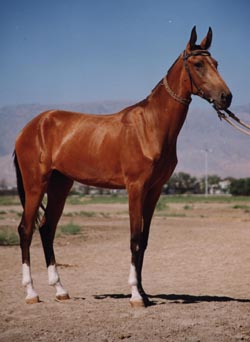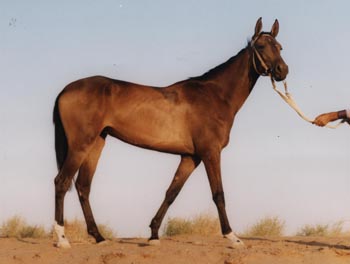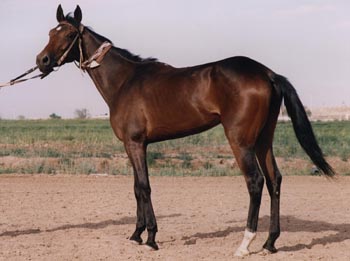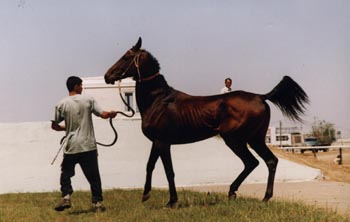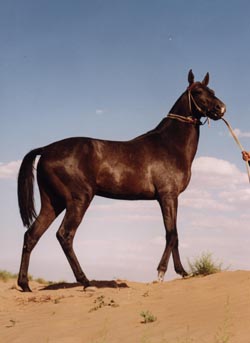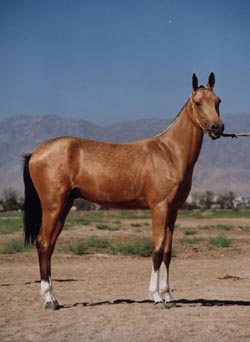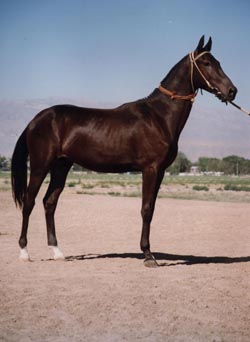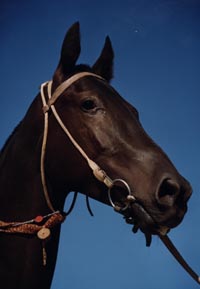ahalteke.net
Network & Organization of ahalteke horses
a member of

|
Turkmen Horses Turkmen horses Video “Ahalteke”(In
English)
The world today is home to more than 250 breeds of horses cultivated by man over many centuries. The Akhalteke breed stands apart as the patrarch of horse-breeding. It took more than three millenia to produce this breed. The exact date of the Ahalteke breed's first appearance is not known, but earliest mentions go back to the 4th-3rd century B.C. Bucephalus, the favourite horse of Alexander the Great, was Akhalteke.
Breeding secrets were
passed down from father to son. The horse was their first friend and closest
ally.
Akhal Teke
Physical Description The Akhal-Teke's conformation can be favorably compared to the Persian Arab, another breed of ancient origin. Its head is similar to the Arab's, being long and light with expressive eyes. It has relatively long ears and a long neck. It has a short silky mane, or none at all, and a short tail. This breed has a narrow chest, long back, and flat ribs. The legs are long and slender, clearly revealing the tendons. It averages 15-15.1 hands in height. It is often dun in color, although it can be bay and gray, with a pale golden coat preferred. The Akhal-Teke is among the most elegant of the world's horses.
Ancient Origins The Akhal-Teke descended from the ancient Turkmenian horse which was one of the four original horse "types" that cross the Bering Strait from America in prehistoric times.. It was originally bred by tribes of Turkoman. The Akhal-Teke now is bred in the other provinces of the southern former U.S.S.R. Records Set by Akhal-Teke Horses
The Akhal-Teke named "Absent" won the Prix de Dressage at the Rome Olympics in 1960. Reference: Kentucky Horse Park, 4089 Iron Works Pike, Hendricks, Bonnie L., International Encyclopedia of Horse Breeds, Univ of Oklahoma Press, 1995
Photographs: Kentucky Horse Park,
The akhalteke is an ancient breed descended from one of the four
horse types that crossed the Bering Strait from the Americas in prehistoric
times.
In appearance the akhalteke horse is similar to its descendent, the Persian Arab, though in size it is more comparable to another of its descendants, the English thoroughbred. The akhalteke has a small thin head, long ears and large eyes. It has a short silky mane or no mane at all, and a short tail. The Turkmen practice of covering their horses with two to three layers of felt blankets to protect against cold in the winter and flies in the summer encouraged a remarkably fine textured coat. Akhaltekes are known for their golden coloring but they can also be white, black, dappled, dun, bay, gray or chestnut colored. Fed a low bulk, high protein diet consisting of alfalfa and barely mixed with mutton fat, the akhalteke maintains its traditionally lean proportions of long sinewy legs, a narrow chest, a long back and flat ribs. The average height of an akhalteke is 15 to 15.1 hands. Its small hooves are unusually hard and are therefore rarely shod. The great speed, elasticity and grace of the akhalteke makes it at once a coveted racer, show jumper and dressage mount. Though spirited in temperament, akhaltekes are by all accounts gentle and loyal to their owners, yet aloof with strangers.
Turkmen tribesmen valued their horses above all else. As a nomadic group situated in a rossroads of cultures they were often required to face enemy conflict and came to rely heavily on the strength, speed and endurance of their horses. The akhalteke’s ability to over great distances of harsh terrain under extreme climatic conditions, and to travel at night, made them indispensable to the Turkmen warriors. Aside from their valiant exertions as warriors’ mounts, akhaltekes were also invaluable in assisting Turkmen nomads with their daily work.
Prior to the Russian occupation of 1917, nearly every Turkmen family owned at least one or two horses. With Bolshevism however, came an end to private ownership and the horses were placed in state-owned stud farms. Rather than surrender their beloved horses to such a fate many tribesmen fled with them to Persia and Afghanistan. When it was then decreed that the horses in the stud farms were to be slaughtered for food, breeders released them into the desert, their natural habitat, thereby preventing what may have resulted in the annihilation of the akhalteke breed within the borders of Turkmenistan. In 1935, fifteen akhaltekes were ridden 3000 kilometers, from Ashgabat to Moscow, in eighty-four days, to demonstrate to Joseph Stalin their formidable strength in the hopes that he would grant his permission for their continued breeding. The campaign was a success. Upon achieving independence in 1991, the government of Turkmenistan defined horse breeding as a nationalistic concern and an art form. The akhalteke has been declared a national treasure and its image graces the state seal of Turkmenistan. Today private ownership of akhaltekes in Turkmenistan is steadily increasing and there are now akhalteke farms in Germany and the United States. Famous Akhaltekes: Absent Winner of the Prix de Dressage at the 1960 Olympics in Rome. In 1968 Absent was named the “World’s Best Sporting Horse.” Dancing Brave Winner of the 1986 Arc de Triomphe Race. Dancing Brave holds the record for the highest price ever paid for a horse; US$50 million. Melekush In 1956 Nikita Krushchev presented Melekush to Queen Elizabeth II of England. He was described by the Royal Equerry as Britain’s “best horse.” Buccephalus The famed favorite horse of Alexander the Great.
Geçmiºini bin ýyllyklardan alan Ahal-teke atlaryna "kudratly alem atlary", "Behiºt atlary", " Cennet atlary" atlary verilmiº. Türkmenler kendi atlary olan ahal-teke atlarynyn tohumlaryny temiz saklamayy ve korumayy bu güne kadar sürdürmüºler.Alimlerin ºu zamanki ilmi araºtyrmalarynda dünyada hesaba alynmyº 250 at tohumlaryndan en büyük geçmiºe sahibi Ahal –Teke tohumudur. Bu atlary öbür tohumlary almakda geniº kullanylanydyr. Yani bir çok atlaryn atasydyr. Bedev atlar Türkmenin sungatydyr. (Tarihi belgeselden)
The akhalteke is an ancient breed descended from one of the
four horse types that crossed the Bering Strait from the Americas in
prehistoric times. Approximately
10,000 years ago, as desertification took hold of Central Asia, Turkmen
tribesmen valued their horses above all else. As a nomadic
Upon
achieving independence in 1991, the government of Turkmenistan
For more information mail to: mailto:allaguli@turkmens.net
The most historical racing horses are ahalteke horses
How Turkmenistan Saved Its Golden Horse BY NAZ NAZAR Why You Should Care? Because Akhal-Teke horses have come back from the brink of
extinction to find their place as a national symbol. The breed of Alexander the Great’s
beloved horse, Bucephalus — whose death grieved Alexander so much that he
founded a city in the steed’s honor — is lost to history. But in
Turkmenistan, there is no doubt: The horse must have been an Akhal-Teke. These horses, famed as much for their
golden-brown metallic sheen as for their speed and endurance, have been bred
on what is now Turkmen soil for thousands of years, long before the country
gained its independence from the Soviet Union in 1991. They’re legendary as
the steeds of Turkmenistan’s ancient nomadic tribes, unbeatable in the desert
for their ability to go long distances in extreme heat. And less than 40
years ago, they were on the verge of extinction. Even today, fewer than 6,000
Akhal-Tekes remain, most of them in Russia and
Turkmenistan. Akhal-Teke enthusiasts like to cite the breed as
an ancestor of the Arabian, though — like so much about ancient horse
breeding — it’s unclear if the two simply have a common ancestor, an older
Turkmen horse. But the breed’s age, says breeder Geldy
Kyarizov, means that if the Akhal-Teke
bloodline is lost, it can never be reconstructed. In fact, he says, loss of
purebred Akhal-Tekes would also mean “other horses
like the Arab and English purebred cannot be restructured, because the Akhal-Teke are their forefathers.” In 1935, 15 Turkmens rode their Akhal-Tekes 2,500 miles, from Ashgabat, Turkmenistan’s
capital, to Moscow. The horses have long been sacred in Turkmenistan,
where eating horse meat is taboo and riders form deep bonds with their
horses. Akhal-Tekes are willful, known to obey only
their trainer or regular rider, and Turkmen legends tell of horses who
shielded their riders in battle or who knelt to allow a wounded fighter to
crawl on their back and carried them to safety. The horses were hand-fed,
protected from cold desert nights and fitted with an alaja, a neck rope
meant to keep evil away. The Akhal-Teke’s
downhill slide began in 1881: Czarist Russian military victories meant
Turkmenistan’s territory was subsumed into the empire, and Turkmen horses
were crossbred with Russian ones. After the Bolshevik Revolution, nomadic
Turkmens were forced to abandon their traditional ways and reorganized by
Soviet authorities. While some armed Turkmen horsemen fought back, they were
eventually driven across the borders of Iran and Afghanistan. Back home, private ownership of horses was made illegal, and Akhal-Tekes were turned over to state farms. Rather than
turn their beloved steeds over to authorities, owners set their horses free
in the desert, hoping the hardy breed would survive the harsh conditions. In
1935, 15 Turkmens hoping to prove the breed’s worth rode their Akhal-Tekes 2,500 miles, from Ashgabat, Turkmenistan’s
capital, to Moscow. It took 84 days, during which they made a three-day
crossing of the Kara-Kum desert without water. The journey drew attention to
the horses, both at home and abroad, and Kazakhstan and Uzbekistan began to
breed Akhal-Tekes as well. In 1956, Soviet leader Nikita Khrushchev
declared that “a single tractor has more worth than 100 horses.” Soviet authorities prized Akhal-Tekes for their beauty. In 1956, the state gifted
Queen Elizabeth II with a golden-dun Akhal-Teke
stallion, and Gen. Georgy Zhukov rode a white Akhal-Teke
stallion — named Arab — through Red Square when the Allies defeated Nazi
Germany. Fifteen years later, Arab’s son Absent won an Olympic gold medal in
dressage, the Soviet Union’s first in the sport. Still, Akhal-Tekes,
bred for endurance, couldn’t best Arabian and English thoroughbred horses in
short sprints. Without medals, their value began to drop, and they were
crossbred with English horses for racing. In 1956, Soviet leader Nikita
Khrushchev declared that “a single tractor has more worth than 100 horses,”
banned and punished private breeding and ordered that thousands of purebred Akhal-Tekes be turned into sausage to feed the populace. Seeing the population of Akhal-Tekes dwindling, a few advocates for the horses —
including Kyarizov, who now lives in the Czech
Republic — knew they had to do something. So they
made a movie. About 20 minutes long, the 1986 documentary History of One
Mileage depicts the horses on an endurance ride, as well as their fate in
slaughterhouses. The film sparked outrage in the international horse
community. Meanwhile, Kyarizov and other breeders
were desperately trying to save the horses by secretly buying their freedom. Communist Party leader Mikhail
Gorbachev, who’d taken power just the year before, would be the horse’s
savior. His appointee to a high-level Turkmen post Saparmurat Niyazov was
known for his severe punishment of anyone violating laws forbidding private
horse ownership. Horse breeders appealed directly to Gorbachev, who
reprimanded Niyazov. Amid the outcry caused by History of One Mileage,
private breeding was made legal again and Turkmenistan stopped delivering Akhal-Tekes to meatpacking plants.
Kyarizov opened a private stud farm in 1992,
just a year after Turkmenistan gained independence; in 1997 he was appointed
head of the country’s state body for regulating horses. The following year,
Ashgabat hosted the first international Akhal-Teke
conference. Saparmurat Niyazov, who had become the president of Turkmenistan
— he remained in power until his death in 2006 — declared April 30 Turkmen
Horse Day. Niyazov’s horse, a purebred Akhal-Teke
stallion named Yanardag, was made the country’s
national emblem in 2003, and his image continues to grace Turkmen postage
stamps and money. Niyazov made
the Akhal-Teke part of his state-building campaign.
More than 1,000 horses paraded for the opening of the presidential palace in
2001. Introduction to the Turkmen Horse in Iran Ali Golshan has contributed
greatly to our knowledge of the Turkoman horse with his book, Introduction to the Turkmen Horse in Iran . Although the breed is more
widely known as the Akhal Teke
from Turkmenistan, its Persian counterpart has played an equal role in the
development of all light breeds of horses in the world. Until the Russian
conquest of Turkmenistan in the early 20th century Turkoman tribes roamed
freely from the Alborz mountain range, over the Atrek
river and through the Kopet Dagh
mountains to the great sand desert. The major tribes of Goklan,
Yamoud and Teke proudly
bred their own strains, basically keeping them seperate.
Today the Akhal Teke is primarily an
amalgam of the different strains. Their Persian counterparts continued to be
bred in the tribal manner and are still identifiable as individual strains
although invariably mixing amongst the strains has occurred. This horse is
gradually regaining recognition in the world as DNA analysis has shown its
blood runs in all our modern breeds of light horse. The genetic contribution
is immense; its history romantic; its form and action flowing and beautiful
and the people who raise them still live as they did 2000 years ago. Mr. Golshan's
book follows long forgotten trails, describes traditional methods of
breeding, training and racing and leaves the reader with a sense of having
lived history. It is beautifully illustrated with color and black and white
photos from the early past to the present. It has been published in a limited edition of 2000 copies so that anyone wishing to
include this invaluable contribution to our knowledge of the horse should not
hesitate to take advantage of this opportunity. Louise Firouz Ghara Tepe Sheikh November, 2005
Introduction to the Turkmen Horse in Iran
In “Golden collection…” is
described more than 80% of brood stock of the Akhal-Teke
breed, focused in You can order our production over the
phones: +7(495)9452478, 9452212 or write on our email. Price: 99 Euro (with delivery). Format: 285*285 sm Volume: 196 pages Edition: 5000 copies Publisher: “Gold Mustang”magazine Dr. Ghiadi: I had come to leave,
but I got stuck Dr. Ghiadi,
the President of the Equestrian Commission of the Province of North Khorasan,
explained the state of horse riding in that province to our reporter: “Across
North Khorasan, there is a treasure of vegetation
variety and living habitats. Here, there are regions such as the
town of Maneh and Somlaqan
in which there exist a lot of thoroughbred horses. In the regions of Gholaman, Dehestan-Raz, Bojnord and some parts of Asfrain-Shirvan
and recently in the region of Faurouje and Judgeroom there have been some tendencies to expand and organize
the horse industry.” “This region is full of wonders. If
you travel for half an hour, you will pass through jungles, snow and deserts.”he said. “These latent
natural conditions have a lot of potentials to fulfill our national interests
but unfortunately much negligence has taken place in the past years.” said
Dr. Ghiadi.“Now, the horses are being dragged from the free
countryside to the cities; this is, of course, a good phenomenon
in essence, but the danger I feel is that the incomplete and substandard
boxes are going to eradicate these horses. The deficient foals cannot be
distinguished in boxes. Of course, now the scientific systems in place in
Tehran are not
bad, but in general the possibility exists that the deficient foals enter the
system of breed improvement and create problems.”“I entered the world of horses and riding very
easily. It was easy to enter but to stay and continue was very difficult.”
said Dr. Ghiadi. “This is the world of hard working
and different types of people; I like this atmosphere. When I first came to Jarglan as a doctor, I was thinking: I have come and I
will leave, but I got stuck.”
Chary Shirliev Perfectly illustrated book - a picture album about Turkmen horses sweaty of blood . For the first time, to attention of readers it is given together 350 breeds of horses of all world. Here You can get acquainted with well known horses of the world, outstanding records to receive the information on ancestors of all Akhalteke lines, to begin involuntary participants of well-known horse run Ashgabat-Moscow 1935 and 1988. A plenty of illustrations, many of which are published for the first time make work especially valuable and unique. The book is addressed to experts in breeding horses, and also for a wide range of readers. Turkmenistan/Ashgabat mkr.Mir
2/1, 23 blok "B" Other Books! Links |
||||||||||||||||||||||||||||||||||||||
|
|


























 The
The















